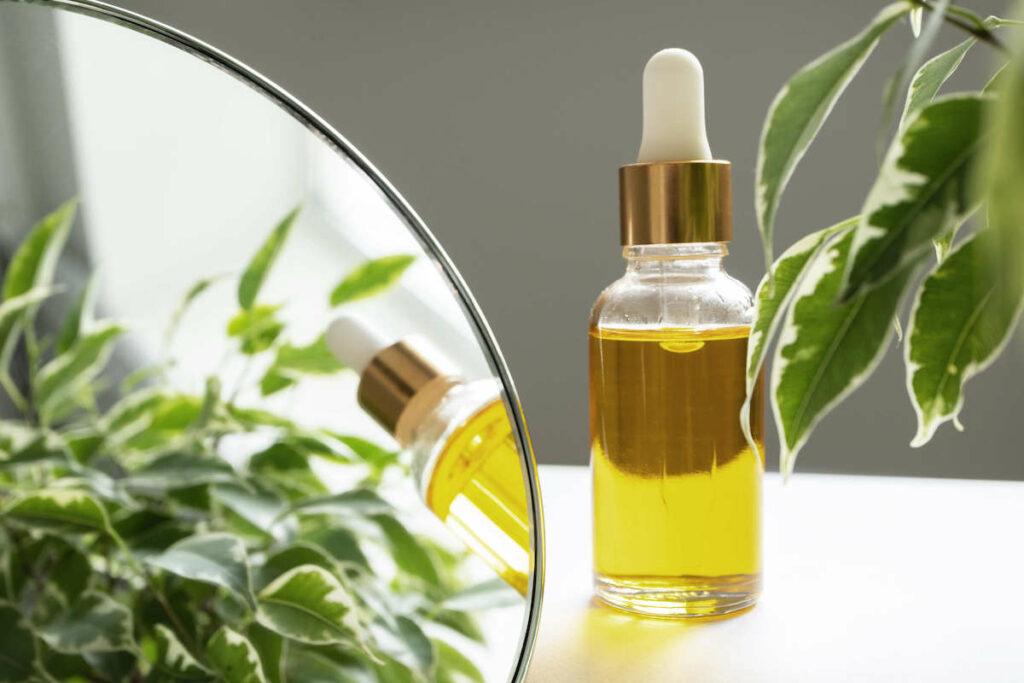Vitamin E. It’s an essential nutrient for a healthy heart and a robust immune system. (16)(24) But did you know that it’s also important for healthy skin? First discovered in 1922, vitamin E has been prized as a potent fat-soluble antioxidant in dermatology for more than 50 years. (13)(20) In fact, vitamin E can be found in many cosmetics and skincare products due to its ability to prevent oxidation. (13) Some research suggests that one form of this important nutrient—vitamin E oil—may also support the health of your skin and scalp when applied topically. (1)(28)

What is vitamin E oil?
Contrary to popular belief, vitamin E isn’t a single nutrient. Rather, it’s made up of a group of eight fat-soluble compounds. These consist of four tocopherols (alpha-, beta-, gamma-, and delta-tocopherol) and four tocotrienols (alpha-, beta-, gamma-, and delta-tocotrienol). (32) The vitamin E used in supplements and cosmetic preparations is typically alpha-tocopherol and can either be in its natural form (listed on labels as D-α-tocopherol) or in its synthetic form (listed on labels as DL-α-tocopherol acetate). (6)(32)
Experimental studies suggest that when taken as a supplement or applied topically, vitamin E may protect the skin from sun damage and harmful free-radicals that can prematurely age the skin and increase the risk of skin cancer. It’s also been shown to help stabilize the skin’s barrier. (11)(28) This is important since the skin barrier, which is located in the uppermost layer of the skin (the stratum corneum), protects the body from environmental pollution and other harmful compounds. It also helps prevent the excessive loss of transdermal moisture. (31)
Aside from being used as an ingredient in many cosmetic formulations, one popular way to apply vitamin E to the skin is as an oil. (29) Commercial vitamin E oils often contain either the pure vitamin in a neutral carrier oil or a blend of oils like argan oil, pumpkin seed oil, sunflower oil, or sweet almond oil that are rich in the nutrient. (10)(18)(25)(32) Topically applied, these vitamin E oil products are popular for preventing premature skin aging, sun damage, and even scars. (13)
Did you know? Alpha-tocopherol is the only form of vitamin E that is recognized to meet human requirements. (32)

Vitamin E oil for skin health
Vitamin E oil is often used to treat a variety of skin conditions, from premature aging to sun damage. Here’s what the science says works and what doesn’t. (7)
Anti-aging
From crow’s feet to dryness to sagging skin, topical vitamin E oil may help prevent and even improve the visible signs of aging. Studies suggest that applying vitamin E to the skin topically may help inhibit the formation of wrinkles and hyperpigmentation (age spots) because of its ability to protect skin from sun damage. (14)(23) In one of these studies, which was conducted on mice, researchers at Duke University Medical Center found that applying vitamin E topically offered direct protection against sun damage and oxidative stress. It also helped thicken the epidermal layer of the skin, effectively reducing the appearance of premature aging. (23) Other research notes that vitamin E reduces skin inflammation, stabilizes the skin barrier, and protects against free radicals that can accelerate the breakdown of collagen and glycosaminoglycans. These actions may help prevent wrinkles and sagging. (13)(21)
Vitamin E oil also appears to have a modest effect on hyperpigmentation—those dark spots on the skin that are caused by aging and years of sun exposure. (13) One study that appeared in the Journal of Cosmetic Dermatology reports that a combination of vitamins A, C, E, and K may also improve dark circles and wrinkling under the eyes when applied topically. (19)
Eczema
This inflammatory skin condition, also known as atopic dermatitis, is marked by dry itchy skin, rashes, scaly patches, blisters, and skin infections. (33) While there is no cure, there is some evidence that topical vitamin E may help relieve symptoms. This was shown in a clinical trial involving 44 people with eczema. Those applying an antioxidant-rich cream containing vitamin E experienced faster improvement in their symptoms compared to the group using a placebo cream. (22) Other research on vitamin E oil attributes its antioxidant and anti-inflammatory properties for the oil’s ability to improve eczema symptoms. (27)
Sun damage
Exposure to the sun’s ultraviolet (UV) rays doesn’t just accelerate skin aging, it can also increase your risk of developing skin cancer. That’s because these harmful rays—especially UVB rays—directly damage the DNA in skin cells. (30) Some preliminary research suggests that because topically applied vitamin E not only fights free radicals but also thickens the skin, it may reduce the detrimental impact of UV exposure. (11)(23) Other studies have found that combining vitamin E oil with vitamin C and ferulic acid increases UVB protection when applied topically. (9) But while these studies seem promising, human trials have yet to confirm these same benefits. (13)
Did you know? Topical vitamin E has been shown to improve granuloma annulare—a non-infectious skin condition that causes raised bumps in a ring pattern—in as little as 12 days, and without the side effects common to some treatments. (12)
Vitamin E oil for scarring
People have been trying to prevent or minimize scarring with topical vitamin E for years. Does it work? While some studies do show improvement in the cosmetic appearance of scars, most found no benefit. (3)(26) What’s more, some of these investigations found that topical vitamin E may worsen the appearance of scars. (3)

Vitamin E oil for hair and scalp
Some studies suggest that vitamin E may boast benefits to your hair and scalp. Most of this evidence focuses on hair growth, especially in people suffering from androgenic alopecia—a common form of hair loss in both males and females. (17) In one small study of 21 volunteers, supplementing with vitamin E increased hair growth by 34.5%. (4) What about topical formulations? Because vitamin E oil has antioxidant properties that may help reduce oxidative stress in the scalp, some researchers suggest that applying the nutrient topically may encourage hair growth by supporting a healthy scalp. (1)Vitamin E has also been shown to safely and effectively treat head lice. In one human study conducted at Cambridge, British researchers reported that a vitamin E oil spray was significantly more effective at eradicating head lice than permethrin. The vitamin E spray was also better tolerated than the insecticide. (5)
Vitamin E oil safety and storage
Although generally considered safe, some people may experience an allergic reaction to topical vitamin E oil. (15) Because of this, consider doing a patch test before using the oil. Simply apply a small amount to an area of the skin that’s not highly visible like the back of the knee or the inside of the elbow and wait for 24 to 48 hours. If no reaction occurs (such as redness or itching), the oil is likely safe to use. Although vitamin E itself is slow to oxidize when exposed to air, products that contain oils rich in the nutrient may be more prone to oxidation. (2)(8)(10)(13) To minimize the chances of this, always store your vitamin E oil in a cool, dry, and dark place after opening the product.
The bottom line
Vitamin E has been used in dermatology for more than five decades because of its antioxidant and anti-inflammatory properties. Research suggests that when applied topically, vitamin E oil neutralizes damaging free radicals and may help to protect against sun damage and the visible signs of photoaging. There is also some evidence that vitamin E may encourage hair growth in those suffering from alopecia. However, to date, there is little support for vitamin E oil’s ability to prevent or reduce scarring or to promote healthy hair growth.
- Ashique, S., Sandhu, N.K., Haque, S.N., & Koley, K. (2020). A systemic review on topical marketed formulations, natural products, and oral supplements to prevent androgenic alopecia: A review. Natural Products and Bioprospecting, 10(6), 345–365.
- Bardaa, S., Ben Halima, N., Aloui, F., Ben Mansour, R., Jabeur, H., Bouaziz, M. & Sahnoun, Z. (2016). Oil from pumpkin (Cucurbita pepo L.) seeds: evaluation of its functional properties on wound healing in rats. Lipids in Health and Disease, 15, 73.
- Baumann, L.S. & Spencer, J. (1999). The effects of topical vitamin E on the cosmetic appearance of scars. Dermatological Surgery, 25(4), 311-5.
- Beoy, L.A., Woei, W.J., & Hay, Y.K. (2010). Effects of tocotrienol supplementation on hair growth in human volunteers. Tropical Life Sciences Research, 21(2), 91–99.
- Burgess, I.F., Burgess, N.A. & Brunton, E.R. (2013). Tocopheryl acetate 20% spray for elimination of head louse infestation: A randomised controlled trial comparing with 1% permethrin creme rinse. BMC Pharmacology & Toxicology, 14, 43.
- Cheng, K., Niu, Y., Zheng, X.C., Zhang, H., Chen, Y.P., Zhang, M., Huang, X.X., … Wang, T. (2016). A comparison of natural (D-α-tocopherol) and synthetic (DL-α-tocopherol acetate) vitamin E supplementation on the growth performance, meat quality and oxidative status of broilers. Asian-Australasian Journal of Animal Sciences, 29(5), 681–688.
- Chiu, A. & Kimball, A.B. (2003). Topical vitamins, minerals and botanical ingredients as modulators of environmental and chronological skin damage. British Journal of Dermatology, 149(4), 681-91.
- Crapiste, G.H., Brevedan, M.I.V. & Carelli, A.A. (1999). Oxidation of sunflower oil during storage. Journal of the American Oil Chemists’ Society, 76, 1437.
- de Oliveira Pinto, C.A.S. , Martins, T.E.A. , Martinez, R.M. , Freire, T.B. , Velasco, M.V.R. & Baby, A.R. (2021). Vitamin E in human skin: Functionality and topical products. In P. Erkekoglu, & J. S. Santos (Eds.), Vitamin E in Health and Disease – Interactions, Diseases and Health Aspects. IntechOpen.
- Gharby, S. & Charrouf, Z. (2022). Argan oil: Chemical composition, extraction process, and quality control. Frontiers in Nutrition, 8, 804587.
- Godic, A., Poljšak, B., Adamic, M., & Dahmane, R. (2014). The role of antioxidants in skin cancer prevention and treatment. Oxidative Medicine and Cellular Longevity, 2014, 860479.
- Goldstein, R.K., Zillikens, D., Miller, K., Elsner, P., Burg, G. (1991). Local treatment of disseminated granuloma annulare with a vitamin E emulsion. Hautarzt, 42(3), 176-8.
- Keen, M. A., & Hassan, I. (2016). Vitamin E in dermatology. Indian Dermatology Online Journal, 7(4), 311–315.
- Konger RL. (2006). A new wrinkle on topical vitamin E and photo-inflammation: Mechanistic studies of a hydrophilic gamma-tocopherol derivative compared with alpha-tocopherol. Journal of Investigative Dermatology, 126(7), 1447-9.
- Kosari, P., Alikhan, A., Sockolov, M. & Feldman, S.R. (2010). Vitamin E and allergic contact dermatitis. Dermatitis, 21(3), 148-53.
- Lee, G.Y. & Han, S.N. (2018). The role of vitamin E in immunity. Nutrients, 10(11), 1614.
- McElwee, K.J. & Shapiro, J.S. (2012). Promising therapies for treating and/or preventing androgenic alopecia. Skin Therapy Letter, 17(6), 1-4.
- Melhaoui, R., Kodad, S., Houmy, N., Belhaj, K., Mansouri, F., Abid, M., Addi, M., … Elamrani, A. (2021). Characterization of sweet almond oil content of four European cultivars (Ferrangnes, Ferraduel, Fournat, and Marcona) recently introduced in Morocco. Scientifica, 2021, 9141695.
- Mitsuishi, T., Shimoda, T., Mitsui, Y., Kuriyama, Y., & Kawana, S. (2004). The effects of topical application of phytonadione, retinol and vitamins C and E on infraorbital dark circles and wrinkles of the lower eyelids. Journal of Cosmetic Dermatology, 3(2), 73-5.
- Niki, E. & Traber, M.G. (2012). A history of vitamin E. Annals of Nutrition and Metabolism, 61(3), 207-12.
- Pandel, R., Poljšak, B., Godic, A., & Dahmane, R. (2013). Skin photoaging and the role of antioxidants in its prevention. ISRN Dermatology, 2013, 930164.
- Patrizi, A., Raone, B., Neri, I., Gurioli, C., Carbonara, M., Cassano, N. & Vena, G.A. (2016) Randomized, controlled, double-blind clinical study evaluating the safety and efficacy of MD2011001 cream in mild-to-moderate atopic dermatitis of the face and neck in children, adolescents and adults. Journal of Dermatological Treatment, 27(4), 346-50.
- Ritter, E.F., Axelrod, M., Minn, K.W., Eades, E., Rudner, A.M., Serafin, D., Klitzman, B. (1997). Modulation of ultraviolet light-induced epidermal damage: Beneficial effects of tocopherol. Plastic and Reconstructive Surgery, 100(4), 973-80.
- Sozen, E., Demirel, T., & Ozer, N.K. (2019).Vitamin E: Regulatory role in the cardiovascular system. IUBMB Life, 71(4), 507-515.
- Stevenson, D.G., Eller, F.J., Wang, L., Jane, J.L., Wang, T., & Inglett, G.E. (2007). Oil and tocopherol content and composition of pumpkin seed oil in 12 cultivars. Journal of Agriculture and Food Chemistry, 55(10), 4005-13.
- Tanaydin, V., Conings, J., Malyar, M., van der Hulst, R. & van der Lei, B. (2016). The role of topical vitamin E in scar management: A systematic review. Aesthetic Surgery Journal, 36(8), 959-65.
- Teo, C.W.L., Tay, S.H.Y., Tey, H.L., Ung, Y.W. & Yap, W.N. (2021). Vitamin E in atopic dermatitis: From preclinical to clinical studies. Dermatology, 237, 553-564.
- Thiele, J.J. & Ekanayake-Mudiyanselage, S. (2007). Vitamin E in human skin: organ-specific physiology and considerations for its use in dermatology. Molecular Aspects of Medicine, 28(5-6), 646-67.
- Thiele, J.J., Hsieh, S.N., & Ekanayake-Mudiyanselage, S. (2005). Vitamin E: Critical review of its current use in cosmetic and clinical dermatology. Dermatologic Surgery, 31(7 Pt 2), 805-13; discussion 813.
- Ultraviolet (UV) radiation. (2019). American Cancer Society. https://www.cancer.org/cancer/cancer-causes/radiation-exposure/uv-radiation.html
- van Smeden, J. & Bouwstra, J.A. (2016). Stratum corneum lipids: Their role for the skin barrier function in healthy subjects and atopic dermatitis patients. Current Problems in Dermatology, 49, 8-26.
- Vitamin E. Fact sheet for health professionals. (2021). National Institutes of Health, Office of Dietary Supplements. https://ods.od.nih.gov/factsheets/VitaminE-HealthProfessional/#en1
- What is eczema? National Eczema Association. https://nationaleczema.org/eczema/





